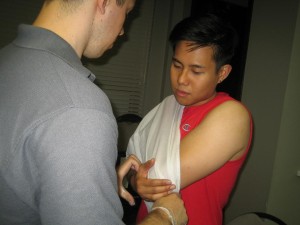A clavicle fracture is also called as a broken collarbone. This typically occurs in individuals of all ages. The clavicle is directly located over vital blood vessels and nerves. On the other hand, these essential structures are rarely damaged once the clavicle is damaged.
[youtube url=”http://www.youtube.com/watch?v=IHgtkuGQRJU”]Causes of clavicle fracture
Fractures on the clavicle or collarbone are usually caused by a direct blow to the shoulder. Understandably, this can occur if an individual falls and lands on the shoulder or during a vehicular collision. During a fall, if the individual outstretched his/her hands, it can also lead to a fracture. As for babies, this fracture can occur when passing through the birth canal.
Symptoms of clavicle or collarbone fracture
Always bear in mind that fractures on the clavicle can cause a lot of pain and it is difficult to move the affected arm. Other symptoms can also occur such as:
- Inability to raise the affected arm due to pain
- Shoulder that sags downwards and in a forward manner
- Sensation of grinding if the individual tries to lift the arm
- Deformity over the affected area
- Swelling, tenderness or bruising on the collarbone area
How a clavicle fracture is diagnosed
Once a doctor is consulted, questions are asked regarding the injury and how it occurred. The shoulder will also be examined and there is a distinct deformity at the affected area. The application of minimal pressure over the area can cause pain. Careful assessment is carried out to determine if the blood vessels or nerves are damaged.
An X-ray is performed to figure out the location and the severity of the injury. In case other bones are involved, a CT scan is carried out to provide a clearer view of the damage.
Treatment for clavicle fracture
Once the ends of the broken bones have not moved out of place and lined up appropriately, surgery is not required. Always remember that broken collarbones can heal without surgery.

- Administer medications for pain such as acetaminophen to help minimize pain as the fracture undergoes the healing process.
- Support can be provided by an arm sling or figure-of-eight wrap for comfort right after the break. These are used to provide support to the affected arm as well as keeping it in position during the healing process
- Physical therapy is required since muscle strength is lost when the sling is used. The moment the bone starts to heal, the pain will subside and the gentle shoulder and elbow exercise are started by your doctor. These exercises will help prevent weakness and stiffness.
- Follow-up with your doctor on a regular basis until the fracture is fully healed.
Complications of a clavicle fracture
There is a possibility that the fracture can move out of its position before it heals. With this in mind, it is important to follow up with your doctor regularly to ensure that the bone remains in its proper position. In case the fragments of the fracture moved out of place and they heal in that position, it is known as a malunion. The treatment of this is determined by the extent of the movement of the bones as well as how it affects the movement.